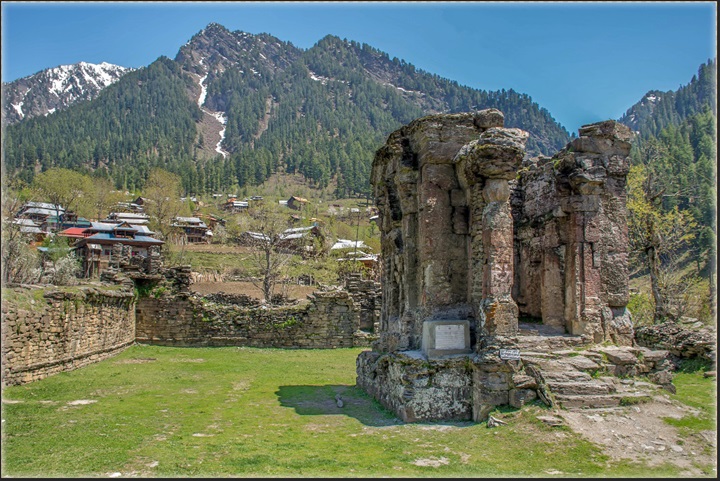 |
 |
 |
http://www.varalaaru.com A Monthly Web Magazine for South Asian History [187 Issues] [1839 Articles] |
 |
 |
 |
http://www.varalaaru.com A Monthly Web Magazine for South Asian History [187 Issues] [1839 Articles] |
|
Issue No. 180

இதழ் 180 [ ஆகஸ்ட் 2024 ] 
இந்த இதழில்.. In this Issue.. 
|
The fact that Kashmir has only a small number of stone temples makes them even more remarkable as architectural marvels. A considerable number of them display a notable amount of deterioration. According to historical chronicles, it is believed by scholars that the destruction of Hindu Temples in Kashmir was a result of the actions of Sultan Sikander, who gained notoriety for his role as an iconoclast and desecrator of religious sites. Despite the existence of differing viewpoints, it is vital to acknowledge that a considerable number of geologists attribute the primary cause of these destructions to the Himalayan Earthquakes. Our study's primary objective is to gain a deeper understanding of the situation, and we firmly believe that focusing on the Sarda temple will allow us to accomplish this goal. The main goal of this study is to establish that the decline of the Sarda temple was not an isolated event or a deliberate action, but rather a direct outcome of several contributing factors that caused its gradual deterioration. The former princely state of Jammu and Kashmir boasts a mesmerizing natural landscape that is enhanced by the presence of numerous holy sites, making it even more charming. Within the Azad Kashmir region, one can discover a plethora of temples among the many ancient holy sites that are scattered throughout. The temples in this region have suffered greatly as a consequence of the Line of Control (LoC) and the mass exodus of Hindus in 1947, leading to their abandonment and subsequent deterioration. Sharda temple, which holds a significant place in history as the renowned center of learning in the Indian sub-continent, has managed to endure and survive. The origin of this enigmatic entity becomes even more perplexing due to the absence of tangible evidence. The holy sites in Kashmir are not only regarded as places of worship for different religious factions, but they also carry a profound meaning. These sites embody a philosophy of peace, love, and harmony that surpasses boundaries and is strongly influenced by the teachings of the revered Rishis from earlier eras.  (Picture courtesy By Umar Jamshaid –Source Wiki pedia) The preservation of this archaeological site, which holds immense importance, sacredness, and cultural significance, requires an urgent response to adequately tackle the concerns that have arisen. Historical Background One of the factors that contribute to the everlasting beauty of the Jammu & Kashmir region (Kashmir) is the existence of several holy sites, which further enhance its allure. Visitors from near and far are drawn to Kashmir, a land of eternal beauty, where they can explore an abundance of sacred sites. The temples in Jammu have a unique charm that is both spiritual and aesthetically appealing, making them dear to the hearts of visitors. The multitude of holy sites found in these places is a remarkable feature that showcases the diversity of religious traditions. Throughout the centuries, the people of Kashmir have consistently demonstrated an exceptional trait of religious harmony, coming together to visit sacred sites irrespective of their personal beliefs and religious affiliations. The Sharda Temple in Kashmir is highly regarded by individuals from diverse backgrounds as a sacred place that goes beyond religious and geographical boundaries, thus earning their utmost respect. In Azad Jammu & Kashmir, specifically in the Neelum Valley, lies the village of Sharda, which is around 140 kilometers distant from the capital city of Muzaffarabad. This particular place is located about 30 kilometers from Kupwara, a town situated in Indian Head Kashmir. Being situated just a few miles away from the Line of Control (LoC), Sharda finds itself encompassed within a highly sensitive military zone, adding to its unique location. The builders took great care in selecting the location for the construction of the structure, considering the sacredness of the Madhumatti stream which originates from the Sarasvati lake on the Narda peak. The importance of building this peak on the right bank of the stream is emphasized by the fact that it is believed to be the birthplace of Shivaji in Hindu beliefs. The decision to build it on the right bank of the Madhumatti stream was made by the builders, considering its unique place in Hindu beliefs. According to their belief, the Sarasvati lake on top of Narda peak is considered to be the birthplace of Shivaji, and they believe that it is from this sacred location that it originates. Taking into consideration this fact, it was deemed appropriate by the Hindu community to dedicate the Sharda Temple to the revered goddess Sharda Devi. Additionally, other communities also perceive it as an essential component of their vibrant cultural heritage, filling them with immense pride for their native land. As a result, it is widely accepted by the public that Kashmir holds the esteemed title of Sharda Peeth, a divine location. The settlement patterns of people in this rugged and inhospitable mountainous terrain with a harsh climate remains an ongoing puzzle that researchers are actively exploring. Social scientists have put forward the idea that sometime around 3000 B.C., a group of Aryans, who were initially planning to settle in India, ended up unintentionally altering their course and eventually formed a settlement in this particular region (Kaul, n.d.). The validity of this theory remains a topic of debate among scholars, who continue to actively engage in discussions despite their differing opinions. The Shiva Temple at Vijeshwari (Bijbehra) was built by none other than Ashoka, the famous Buddhist ruler, with the aim of fostering religious tolerance and embracing multiculturalism in the region. Consequently, his actions had a profound impact, earning him the affection and support of the local residents, the majority of whom were devout followers of Lord Shiva. The formation of the classical Kashmiri culture was greatly influenced by the growth and influence of Buddhism in Kashmir, resulting in its reach extending to nearby Ladakh and beyond. As time progressed, a significant number of Kashmiri Pandit families, comprising of Hindus with diverse occupations such as priests and local traders, took the initiative to establish their households in Sharda village, an area situated nearby the Temple. The origins of Sharda Temple have become a subject of intense debate among scholars and archaeologists due to the absence of concrete evidence, leading to continuous discussions and disagreements regarding its exact timeframe. The reign of the Kushanas is often mentioned in traditional accounts as the period when the Sharda Temple is said to have been established. Several historians who oppose this theory assert that the construction of the Sharda Temple was not a one-time event, but rather a process that unfolded in various stages. There were multiple reasons that motivated them to propose the construction of the temple, one of which was their deep-seated passion for erecting sacred places of worship. Additionally, they sought to curtail the growing religious and political dominance of Buddhism in the area. It is evident from the remaining portion of the north end that the inside porch-way was constructed in the trefoil style, a design commonly associated with the Aryans. Furthermore, the porch-way featured a straightforward square entrance that was prominently positioned at its center. Therefore, considering the information at hand, it is reasonable to make the assumption that Lalitaditya played a role in the construction of the Sharda Temple, despite the area being heavily influenced by Buddhists. Sharada Peetam – A Hub of Wisdom In ancient times, the religious centers had a multitude of functions, as they were not solely dedicated to worship, but also played a crucial role in fostering knowledge and facilitating spiritual development. The Sharda civilization's influence on the Kashmiris cannot be overstated. Their impact on Hinduism went far beyond introducing fresh philosophical perspectives, as they completely revolutionized the architectural techniques employed in Kashmir. In the 8th century, the scholars who hailed from Kashmir played a pivotal role by making remarkable contributions through their work on the development of the Sharda script. The collaborative efforts of individuals led to the creation of this script, which has become widely used in India as a powerful medium of communication. The extensive usage of this can be observed in both spoken and written forms, emphasizing its importance (Kaul, n.d). The Sharda script, which was an evolved version of the Brahmi script, had been approved by linguistics experts in the past as a suitable writing system for the Kashmiri language. The esteemed reputation of Sharda as a hub of knowledge has spread far and wide, resulting in scholars from neighboring countries being drawn to the institution in search of spiritual enlightenment. Alberuni, the renowned explorer from the 10th century, documented in great detail the fervent journeys undertaken by people from Kashmir and its neighboring regions to the sacred site of Sharda, which served as a pilgrimage destination for seeking the divine blessings bestowed by goddess Sharda. In the year 632 A.D, the renowned Chinese Buddhist monk Xuanzang, who is also known as Hue-en-tsang, made a visit to the beautiful region of Kashmir. During his stay in Kashmir, he chose to reside in the peaceful town of Sharda for an extended duration of nearly two years. Throughout his time there, he became increasingly impressed by the Pandits, who were known for their exceptional brilliance, insightful wisdom, and remarkable genius, and this experience led to the development of a strong appreciation for them. Historians have engaged in discussions about whether Sharda University was present in Kashmir during the Kushan eras; however, despite thorough searches carried out at the Sharda Temple, no remnants or ruins associated with the university have been discovered. Although one cannot completely disregard the possibility of a university or educational institution being present in the area, it is crucial that an extensive investigation be carried out on a national level to establish the truth. The Sharda Temple holds a special place in the hearts of Hindus, Buddhists, and Muslims, who all visit this sacred site to experience its significance, irrespective of their religious affiliations. The profound impact of the partition of the Indian Subcontinent in 1947 and the subsequent migration of the Hindu community across the Line of Control (LoC) cannot be understated, especially when considering its effect on the Sharda Temple. Due to these events, the temple has become completely cut off from its worshippers, resulting in a state of isolation. However, it is important to highlight that indigenous visitors from various regions across the country frequently visit this site, as it holds immense significance to their cultural heritage. |

சிறப்பிதழ்கள் Special Issues 

புகைப்படத் தொகுப்பு Photo Gallery 
|
| (C) 2004, varalaaru.com. All articles are copyrighted to respective authors. Unauthorized reproduction of any article, image or audio/video contents published here, without the prior approval of the authors or varalaaru.com are strictly prohibited. | ||